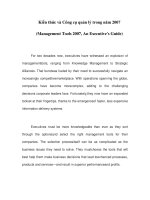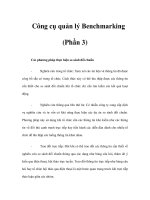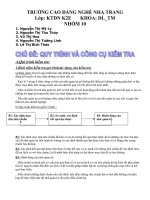Tài liệu Kiến thức và Công cụ quản lý trong năm 2007 ppt
Bạn đang xem bản rút gọn của tài liệu. Xem và tải ngay bản đầy đủ của tài liệu tại đây (62.22 KB, 7 trang )
Kiến thức và Công cụ quản lý trong năm 2007
(Management Tools 2007, An Executive's Guide)
For two decades now, executives have witnessed an explosion of
managementtools, ranging from Knowledge Management to Strategic
Alliances. That burstwas fueled by their need to successfully navigate an
increasingly competitivemarketplace. With operations spanning the globe,
companies have become morecomplex, adding to the challenging
decisions corporate leaders face. Fortunately,they now have an expanded
toolset at their fingertips, thanks to the emergenceof faster, less expensive
information delivery systems.
Executives must be more knowledgeable than ever as they sort
through the optionsand select the right management tools for their
companies. The selection processitself can be as complicated as the
business issues they need to solve. They mustchoose the tools that will
best help them make business decisions that lead toenhanced processes,
products and services—and result in superior performanceand profits.
Successful use of such tools requires understanding the strengths
and weaknessesof each tool, as well as an ability to creatively integrate
the right tools, in the rightway, at the right time. The secret is not in
discovering one magic device,but inlearning which mechanism to use, how
to use it, and when. In the absenceofobjective data, groundless hype
makes choosing and using management tools adangerous game of
chance. To help inform managers about the tools available
to them, in 1993 Bain & Company launched a multiyear research
project to gatherfacts about the use and performance of management
tools. Our objective was toprovide managers with:
•An understanding of how their current application of these tools and
subse-quent results compare with those of other organizations across
industriesand around the globe;
•The information they need to identify, select, implement and
integrate theright tools to improve their company’s performance.
Every year or two since, we’ve interviewed senior managers and
conducted researchto identify 25 of the most popular and pertinent
management tools. We’ve definedthe tools in this guide and, based on a
detailed survey of managers, we explain howthe tools are being used. We
determine the rate of success for each tool. We alsoconduct one-on-one
follow-up interviews to learn the circumstances in which eachtool is most
likely to produce the desired results.
Balanced Scorecard
Related topics
•Management by Objectives
and Vision Statements
•Pay for Performance
•Strategic Balance Sheet
Description
A Balanced Scorecard defines what management means by
“performance” and measures whether management is
achievingdesired results. The Balanced Scorecard translates <st1:city
w:st="on"><st1:place w:st="on">Mission</st1:place></st1:city> andVision
Statements into a comprehensive set of objectives andperformance
measures that can be quantified and appraised.Thesemeasures typically
include the following categories of performance:
•Financial performance (revenues, earnings, return oncapital, cash
flow);
•Customer value performance (market share, customersatisfaction
measures, customer loyalty);
•Internal business process performance (productivityrates, quality
measures, timeliness);
•Innovation performance (percent of revenue from newproducts,
employee suggestions, rate of improvement index);
•Employee performance (morale, knowledge, turnover,use of best
demonstrated practices).
Methodology
To construct and implement a Balanced Scorecard,managers
should:
•Articulate the business’s vision and strategy;
•Identify the performance categories that best linkthe business’s
vision and strategy to its results
(e.g., financial performance, operations, innovation,employee
performance);
•Establish objectives that support the business’svision and strategy;
•Develop effective measures and meaningful standards,establishing
both short-term milestones and long-term targets;
•Ensure companywide acceptance of the measures;
•Create appropriate budgeting, tracking, communication,and reward
systems;
•Collect and analyze performance data and compare actualresults
with desired performance;
•Take action to close unfavorable gaps.
Common uses
A Balanced Scorecard is used to:
• Clarify or update a business’s strategy;
• Link strategic objectives to long-term targets and annual budgets;
• Track the key elements of the business strategy;
• Incorporate strategic objectives into resource allocation processes;
• Facilitate organizational change;
• Compare performance of geographically diverse business units;
Benchmarking









